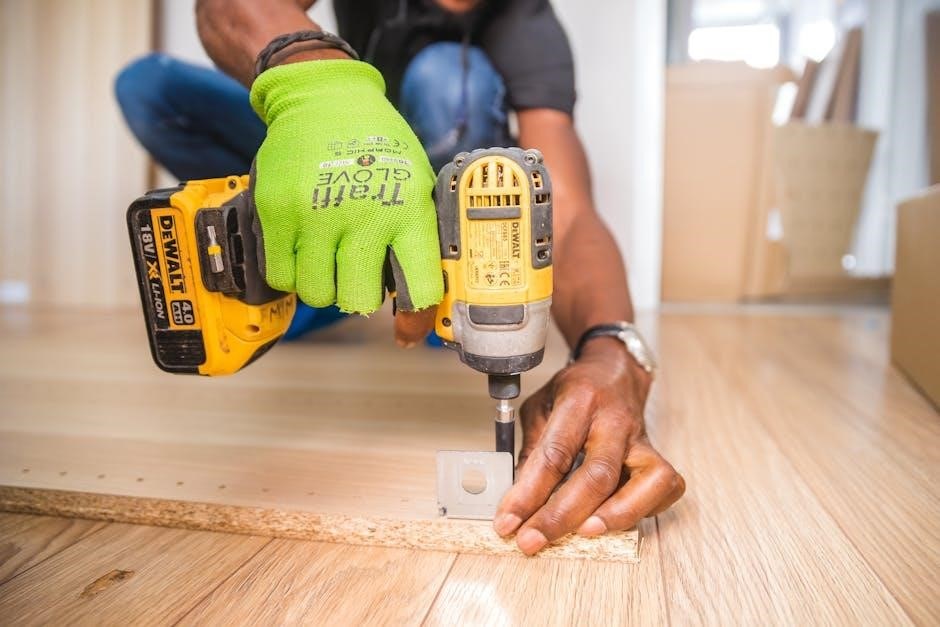Overview of Form 8288
Form 8288 is the U.S. Withholding Tax Return for Dispositions by Foreign Persons of U.S. Real Property Interests. It is used to report and transmit withheld taxes under FIRPTA regulations, ensuring compliance with U.S. tax laws for foreign sellers. The form is crucial for calculating and reporting the correct withholding amounts, making it a key document in international real estate transactions.
1.1 Purpose of Form 8288
The primary purpose of Form 8288 is to report and transmit taxes withheld under the Foreign Investment in Real Property Tax Act (FIRPTA). It ensures that foreign persons comply with U.S. tax laws when disposing of U.S. real property interests. The form is used to calculate and report the correct amount of withholding tax, providing documentation for both the IRS and the transferor. This ensures transparency and adherence to federal tax regulations in international real estate transactions.
1.2 Who Must File Form 8288
Form 8288 must be filed by the withholding agent, typically the buyer or transferee, when a foreign person disposes of a U;S. real property interest. The withholding agent is responsible for reporting and transmitting the withheld taxes under FIRPTA. This includes situations where foreign persons sell or transfer U.S. real estate, ensuring compliance with federal tax regulations. The form is essential for documenting the transaction and verifying the correct withholding amounts with the IRS.
1.3 Key Terms and Definitions
FIRPTA (Foreign Investment in Real Property Tax Act) mandates withholding on sales of U.S. real property by foreign persons. A withholding agent is the entity responsible for withholding, reporting, and paying taxes. A U.S. real property interest includes land, buildings, and certain ownership rights. The transferor is the foreign seller, while the transferee is the buyer. Understanding these terms is essential for accurate form completion and compliance with IRS regulations.

When to File Form 8288
Form 8288 must be filed within 20 days of the sale or transfer of U.S. real property interests by foreign persons. Timely filing ensures compliance with IRS regulations and avoids penalties.
2.1 Filing Deadlines and Requirements
Form 8288 must be filed within 20 days of the sale or transfer of U.S. real property interests. The IRS mandates strict adherence to this deadline to avoid penalties. Extensions may be granted under specific circumstances, such as natural disasters or unforeseen delays. Timely filing ensures compliance with FIRPTA regulations and prevents late-payment penalties. Buyers or withholding agents are responsible for ensuring the form is submitted accurately and on time, maintaining proper documentation for audit purposes.
2.2 Exceptions and Extensions
Certain exceptions may apply, such as when the transferor is not a foreign person or when specific withholding exemptions are met. Extensions for filing Form 8288 may be granted in cases of natural disasters, unforeseen circumstances, or IRS-approved requests. Taxpayers must submit Form 4868 or written requests to the IRS to qualify for extensions. Penalties may still apply if extensions are granted but filing or payment delays occur beyond the approved period.

How to Fill Out Form 8288
Ensure all required documents are gathered, accurate transferor details are provided, and withheld amounts are correctly calculated. Review instructions for exceptions and ensure compliance with FIRPTA regulations.
3.1 Step-by-Step Instructions for Completion
To complete Form 8288, start by identifying the transferor and providing accurate details. Calculate the withholding amount based on FIRPTA regulations. Report the gross sales price and allocate shares if multiple parties are involved. Use Schedule A for additional properties. Ensure all information aligns with IRS guidelines, and review for exceptions. Verify calculations and attach required documents before submission to avoid delays.
3.2 Required Documentation and Attachments
When filing Form 8288, ensure you attach all required documents, such as Form 8288-A for each transferor. Include proof of the transferor’s foreign status, a copy of the sale or exchange agreement, and any certifications for exceptions. Provide documentation supporting the withholding amount and allocations. Attach additional statements if needed to explain complex transactions. Ensure all details are accurate and complete to avoid delays or penalties. Proper documentation is critical for compliance.

Related Forms and Schedules
Form 8288 is often accompanied by Form 8288-A, which provides detailed statements of withholding. Additional documentation, such as sale agreements and transferor certifications, may also be required.
4.1 Form 8288-A: Explanation and Requirements
Form 8288-A serves as a withholding tax statement for foreign persons involved in U.S. real property transactions. It provides detailed information about the transferor, the property, and the withheld amounts. The form must be attached to Form 8288 and distributed to the transferor and the IRS. Copy B is provided to the transferor, while Copy C is retained by the withholding agent for their records, ensuring compliance with FIRPTA regulations.
4.2 Other Supporting Documents
Several supporting documents are required to complete and submit Form 8288 accurately. These include Form W-8 (for foreign persons to certify their status), Form 843 (for claiming refunds), and Form 1040 (to report withheld taxes). Additionally, deeds, settlement statements, and contracts may be necessary to verify property details and transfer terms. These documents ensure compliance and provide a comprehensive record of the transaction for both the IRS and the transferor.

FIRPTA Withholding and Form 8288
FIRPTA withholding requires foreign sellers to withhold up to 15% of the gross sales price on U;S. real property. Form 8288 is used to report and transmit these withheld amounts, ensuring compliance with U.S. tax laws for international transactions. It is essential for accurately calculating and documenting the withholding to avoid penalties or delays in processing. Proper completion of the form ensures all parties meet their tax obligations effectively.
5.1 Understanding FIRPTA Withholding Requirements
FIRPTA withholding applies to foreign persons selling U.S. real property interests (USRPI). A withholding rate of up to 15% of the gross sales price is required. This ensures taxes are collected on potential gains. The withholding agent (typically the buyer) must remit the funds to the IRS. Form 8288 is used to report these amounts. Understanding these requirements is crucial for compliance and avoiding penalties. Proper documentation ensures accurate withholding and timely filing.
5.2 Calculating Withholding Amounts
FIRPTA withholding is typically calculated as 15% of the gross sales price of the U.S. real property interest. The gross sales price refers to the total amount paid for the property, without reductions for mortgages or other liabilities. The buyer, acting as the withholding agent, must remit the withheld amount to the IRS. Form 8288 is used to report and transmit these amounts. Accurate calculation is essential to avoid penalties and ensure compliance with FIRPTA regulations.

Filing and Submission
Form 8288 must be filed with the IRS within 20 days of the sale or transfer of the U.S. real property interest. Ensure accurate submission to avoid penalties.
6.1 Submitting Form 8288 to the IRS
Form 8288 must be submitted to the IRS within 20 days of the sale or transfer of the U.S. real property interest. The form should be mailed to the address listed in the IRS instructions. Ensure all required fields are accurately completed to avoid delays or penalties. Electronic filing options may also be available, depending on the taxpayer’s situation. Always retain a copy for your records and confirm receipt by the IRS.
6.2 Providing Copies to the Transferor
A copy of Form 8288 and Form 8288-A must be provided to the transferor within a specified timeframe. This ensures the transferor has documentation for their tax records and compliance. The transferor may need these copies to claim credits or report withholding on their tax return; Ensure the copies are accurate and complete, as the transferor relies on this information for their filings. Prompt delivery is crucial to avoid delays or discrepancies in their tax obligations.

Common Mistakes to Avoid
Common errors include incorrect reporting of withheld amounts and missing deadlines, leading to penalties. Ensure accuracy in calculations and timely submissions to avoid IRS issues.
7.1 Errors in Reporting Withheld Amounts
Common mistakes include miscalculating withheld amounts, incorrect entries, or omitting required details. Ensure accuracy in reporting by double-checking calculations and verifying transferor information. Errors can lead to penalties or delayed refunds, so careful review is essential before submission. Always cross-reference with FIRPTA guidelines to avoid discrepancies in withholding amounts reported on Form 8288.
7.2 Missing Deadlines and Penalties
Failing to file Form 8288 on time can result in penalties and interest. The IRS requires submission within 20 days of the sale or transfer. Late filing may lead to fines and delayed refunds. Ensure timely submission to avoid penalties, as the IRS enforces strict deadlines for FIRPTA withholding reporting. Missing deadlines can complicate compliance and incur additional costs, emphasizing the importance of prompt action.

Using Tax Software for Form 8288
Tax software streamlines Form 8288 preparation, ensuring accuracy and compliance. Tools like ProSeries and TurboTax support FIRPTA withholding calculations, saving time and reducing errors significantly.
8.1 Benefits of Using Tax Preparation Tools
Tax preparation tools simplify the process of completing Form 8288 by automating calculations, reducing errors, and ensuring compliance with IRS regulations. These tools guide users through complex withholding requirements, providing step-by-step instructions and real-time validation. They also streamline data entry, saving time and minimizing the risk of inaccuracies. Additionally, many software options offer built-in resources and support, making it easier to navigate FIRPTA withholding and ensure accurate submissions to the IRS.
8.2 Popular Software Options
Popular tax preparation tools like ProSeries, TurboTax, and TaxAct offer robust support for Form 8288. These platforms provide user-friendly interfaces, automated calculations, and real-time updates to ensure compliance with IRS regulations. ProSeries, for instance, allows seamless entry of FIRPTA withholding details, while TurboTax and TaxAct offer guided workflows tailored for international transactions. These tools help streamline the filing process, reduce errors, and integrate effortlessly with IRS submission requirements, making them indispensable for accurate and efficient tax reporting.

Additional Resources and Support
The IRS provides detailed instructions for Form 8288 on their official website, along with FAQs and tax professional guidance. Additional support includes consulting tax experts or using tax software help centers for personalized assistance.
9.1 IRS Guidelines and Instructions
The IRS provides comprehensive guidelines for completing Form 8288 in their official instructions, ensuring accurate reporting of FIRPTA withholding. These resources outline eligibility, calculation methods, and filing requirements. Users can access detailed explanations, examples, and FAQs on the IRS website to navigate the process effectively. Adhering to these guidelines helps avoid penalties and ensures compliance with U.S. tax laws for foreign persons disposing of U.S. real property interests.
9.2 Professional Assistance and Consultation
Seeking professional assistance is highly recommended when dealing with Form 8288. Tax attorneys, CPAs, or enrolled agents specializing in FIRPTA can provide expert guidance, ensuring compliance with complex regulations. They help navigate legal requirements, calculate withholding accurately, and avoid penalties. Consulting professionals is especially beneficial for foreign persons unfamiliar with U.S. tax laws, ensuring all obligations are met efficiently and correctly.





